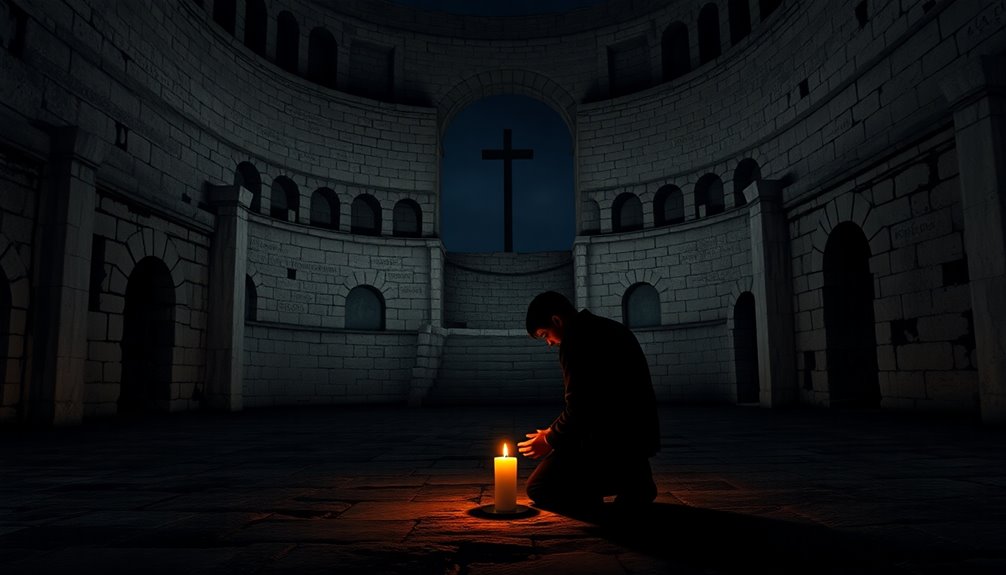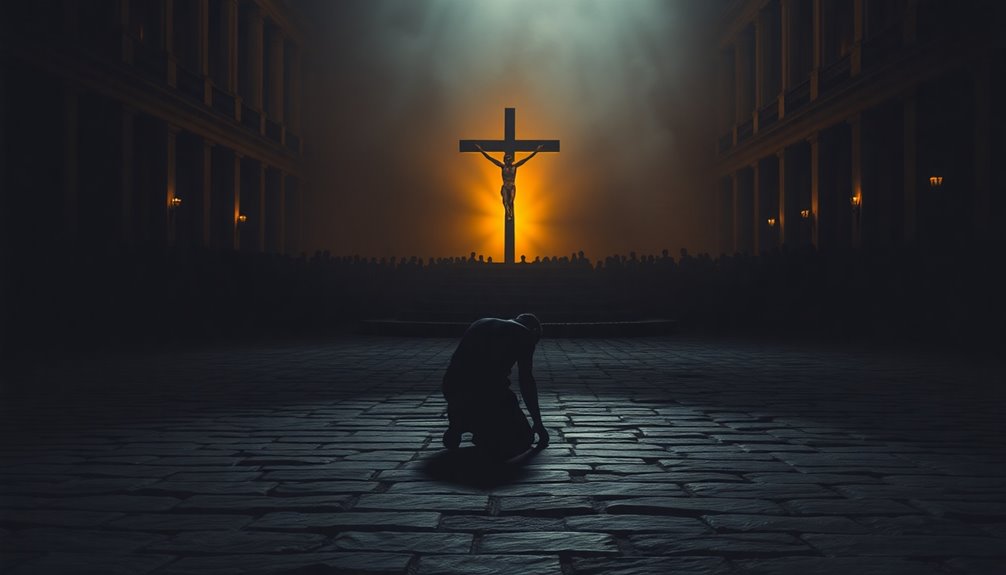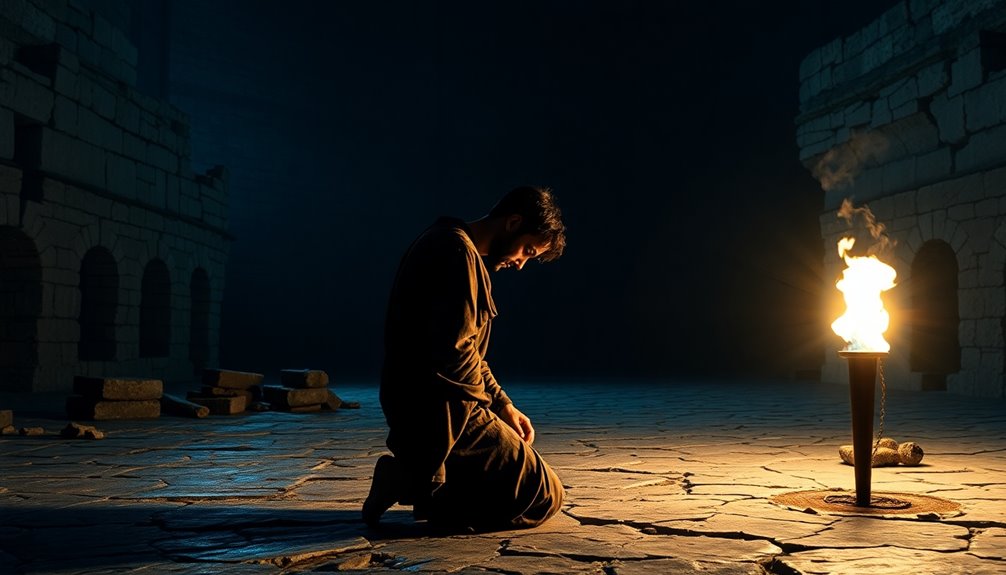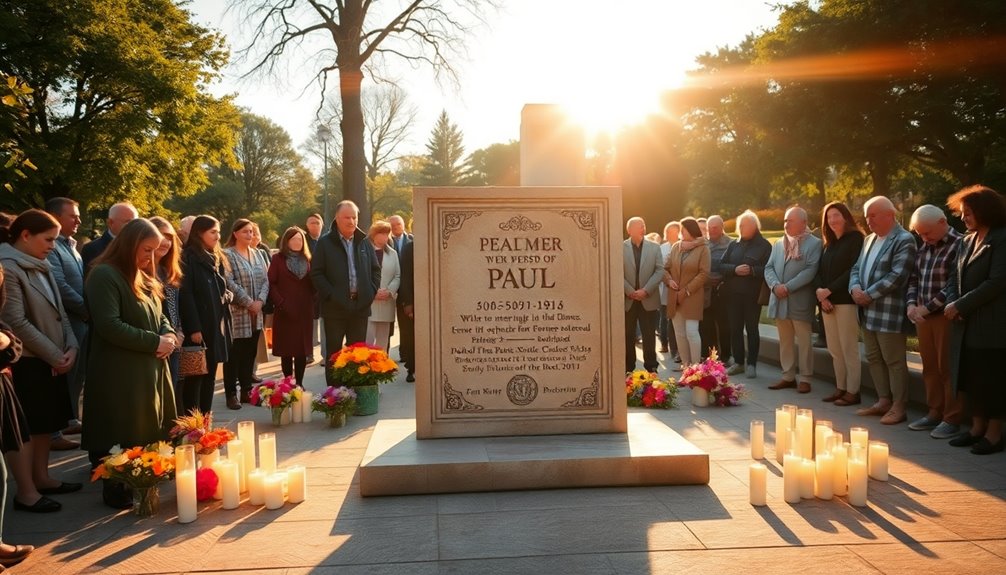Paul died by beheading in Rome during Emperor Nero's reign, around 64-68 AD. He faced intense persecution for spreading the gospel, which ultimately led to his martyrdom. Historical accounts confirm his execution, highlighting his willingness to suffer for his faith as reflected in his writings. His Roman citizenship meant he couldn't be crucified, making beheading the likely method of execution. This event marked the culmination of a life dedicated to spreading Christian teachings. If you're curious about the circumstances leading to his death or its significance, there's much more to uncover about Paul's legacy and impact.
Key Takeaways
- Paul was likely beheaded in Rome under Emperor Nero between 64-68 AD, following the Great Fire of Rome.
- His Roman citizenship exempted him from crucifixion, leading to the method of beheading.
- Scriptural references in 2 Timothy 4:6-8 indicate Paul anticipated his martyrdom, viewing it as a completion of his service.
- Early Christians faced severe persecution during Nero's reign, with Paul likely executed amid widespread brutality against believers.
- Paul's legacy includes influential letters and the establishment of Christian communities, highlighting his transformation and enduring impact on Christian theology.
Introduction

When you think about the life and legacy of Paul, it's hard to overlook the dramatic circumstances surrounding his death. As an apostle, Paul dedicated his life to spreading the gospel, often facing immense challenges and persecution. His unwavering commitment to his mission ultimately led him to Rome, where historical tradition suggests he was beheaded under the reign of Emperor Nero. This execution likely took place between 64 and 68 AD, during a time when Christians were unfairly targeted following the Great Fire of Rome.
Though the Bible doesn't provide explicit details about Paul's death, he anticipated his martyrdom in his letter to Timothy, expressing both readiness and hope. His status as a Roman citizen exempted him from crucifixion, which aligns with the belief that he met his end by beheading, a method considered less brutal.
Early church historian Eusebius and other historical sources highlight that Paul's martyrdom was a direct result of his fearless proclamation of the gospel. This enduring legacy continues to resonate within Christian traditions, honoring his significant contributions to the faith and the early church.
Scriptural Evidence of Martyrdom

When you look at the New Testament, you'll find hints about Paul's martyrdom sprinkled throughout his writings.
Key references like 2 Timothy 4:6-8 and Acts 21:13 highlight his readiness to face death for his faith.
These passages, along with early church accounts, paint a picture of a man committed to his mission, even unto death.
Primary Bible References
Although the Bible doesn't provide explicit details about Paul's death, certain passages offer insights into his mindset and circumstances leading up to it. In 2 Timothy 4:6-8, the apostle Paul reflects on his impending death, describing it as a "drink offering" and expressing his readiness to receive a "crown of righteousness." This imagery suggests that he viewed his death as a completion of his faithful service to God.
Additionally, Acts 21:13 reveals Paul's willingness to suffer for Christ, as he boldly declares his readiness to die in Jerusalem for the name of the Lord Jesus. These verses highlight his commitment to the gospel, even in the face of persecution.
While the New Testament doesn't detail his execution, early church traditions indicate that Paul was martyred in Rome under the reign of Roman emperor Nero, likely between AD 64-68.
Early church historian Eusebius records that Paul was beheaded, a method fitting for his status as a Roman citizen. His final writings, especially in 2 Timothy, underscore his unwavering faith and dedication, suggesting he died proclaiming the message he cherished throughout his life.
Secondary Bible References
While the New Testament may not detail Paul's death, secondary references and historical context provide significant insight into his martyrdom. The Book of Acts concludes without mentioning his end, yet Paul's anticipation of his fate is evident in 2 Timothy 4:6-8. Here, he describes himself as a "drink offering," showing his readiness to face death for the gospel.
Acts 21:13 further emphasizes his commitment, as he expresses a willingness to die for Christ.
Historical accounts suggest that Paul's death occurred during Nero's persecution of Christians, likely between 64-68 AD. Facing execution for his unwavering faith, it's believed that Paul was beheaded in Rome. This aligns with the traditions of the early church, which passed down stories of his martyrdom.
The early church historian Eusebius provides additional evidence, recording details about Paul's execution that have shaped the understanding of his death over time.
These secondary references not only reinforce Paul's dedication but also highlight the brutal realities faced by early Christians under Roman rule, offering you a deeper appreciation for his sacrifice.
Persecution of Early Christians

The persecution of early Christians marked a dark chapter in history, particularly during the reign of Emperor Nero. Following the Great Fire of Rome in July 64 CE, Nero blamed Christians for the disaster, using them as scapegoats to deflect attention from his own failures. This led to a wave of brutal persecution aimed at the followers of Christ, including horrific punishments designed to instill fear.
You'd find Christians used as human torches to light Nero's parties or forced into gladiatorial combats for sport.
Among those persecuted, St. Paul likely faced execution under Nero's orders, a grim fate that many early Christians also endured. The brutal treatment of these believers played a significant role in shaping the early church's understanding of faith, martyrdom, and resilience.
As the church grew, the sacrifices made by figures like Paul fostered a stronger sense of community among believers, solidifying their commitment to their faith despite the risks. This period of persecution not only tested their beliefs but also laid the groundwork for future generations of Christians, who'd look to the courage of martyrs like Paul as an example.
Paul's Unwavering Faith Under Persecution

Demonstrating unwavering faith amid persecution, Paul became a powerful symbol of resilience for early Christians. His writings, especially in 2 Timothy 4:6-8, reveal a man prepared for martyrdom, expressing that he's "fought the good fight" and maintained his faith despite the looming threat of death.
You see, Paul's willingness to suffer for Christ shone through in Acts 21:13, where he boldly declared he was ready to face imprisonment and even death for the name of the Lord Jesus.
During Emperor Nero's brutal persecution of Christians, which followed the Great Fire of Rome, Paul's life exemplified his dedication to spreading the gospel, even when faced with adversity.
He penned numerous letters during his imprisonments, encouraging early Christian communities to remain steadfast in their faith. His anticipation of a "crown of righteousness," as mentioned in 2 Timothy, reflects a deep-seated belief in the eternal reward awaiting those who endure suffering for their faith.
Through his unwavering faith, Paul not only inspired early Christians but also left a legacy that continues to encourage believers today.
Paul's Death Location Confusion

When you explore the details of Paul's death, you'll find a mix of traditions that can be confusing.
While many believe he was martyred in Rome, some early writings suggest he might've traveled to Spain before his execution.
This uncertainty highlights the need to challenge common misconceptions and clarify historical inaccuracies surrounding his final days.
Debunk Common Misconceptions
Confusion often clouds the historical narrative surrounding Paul's death, particularly regarding its location. Many mistakenly believe he could have died elsewhere, but credible historical accounts consistently place Paul's death in Rome.
Traditional records, including those from early church historian Eusebius, confirm that he was martyred during Emperor Nero's reign, specifically between 64-68 CE, after the Great Fire of Rome.
It's essential to note that Paul's status as a Roman citizen significantly influenced the nature of his execution. Unlike the apostle Peter, who was crucified upside down, Paul was likely beheaded, as crucifixion was typically reserved for non-citizens.
This distinction is crucial and helps clarify some misconceptions surrounding their deaths.
Additionally, the broader context of violent persecution against Christians during this period often gets conflated with individual martyrdom stories. While many apostles faced brutal ends, Paul's death stands apart due to its unique ties to his Roman citizenship and the political climate of the time.
Historical Inaccuracies About Paul
Historical narratives about Paul's death often lead to conflicting interpretations regarding its actual location. While many historical accounts pinpoint Rome as the site of his martyrdom, some early traditions suggest he may have died elsewhere, like Spain. This discrepancy arises from various early Christian writings, which contribute to the confusion surrounding the circumstances of Paul's death.
Eusebius, a prominent church historian, firmly asserts that Paul was martyred in Rome, yet other sources challenge this claim, proposing alternative locations. The absence of definitive biblical records about Paul's execution further complicates matters, as the New Testament ends without detailing his final moments.
The differing narratives reflect a broader uncertainty in documenting the lives and deaths of early Christian figures. As you explore these historical accounts, it's crucial to recognize how these conflicting interpretations shape our understanding of Paul's legacy.
The debate over the location of Paul's death not only illustrates the challenges of historical documentation but also highlights the importance of critically examining sources, whether they're from Roman historians or church historians, to gain a clearer picture of early Christianity.
Faith in Adversity

When you face trials, embracing your faith can be a powerful source of strength.
Just like Paul, who found support in his community and kept spreading the gospel despite persecution, you can draw inspiration from those around you.
Together, you can navigate adversity and emerge with a deeper faith.
Embracing Faith During Trials
Facing trials can feel overwhelming, but embracing faith during these difficult times can transform your perspective. Like Paul, who endured imprisonments, beatings, and threats to his life, you can find strength in your commitment to Christ.
Paul viewed these challenges as part of his journey, highlighting the importance of perseverance in the face of adversity. His unwavering faith allowed him to express confidence in God's plan, even when he faced the prospect of martyrdom.
In Philippians 1:21-24, Paul reminds you that living for Christ is paramount, and death brings gain. His readiness to suffer, as stated in Acts 21:13, serves as a powerful example of embracing faith during trials.
When you confront your own hardships, remember Paul's insight that your weakness can reveal Christ's strength (2 Corinthians 12:9-10).
Ultimately, Paul's hope in the "crown of righteousness" awaiting him (2 Timothy 4:6-8) encourages you to maintain faith through struggles. By holding onto this belief, you can navigate your own challenges with a renewed spirit, knowing your perseverance can lead to greater understanding and fulfillment in your faith journey.
Community Support in Trials
Often, the strength to endure trials comes not just from personal faith but also from the support of a community. When facing persecution, as Paul did, you'll find that the encouragement from fellow believers can make all the difference.
Paul's willingness to confront suffering is a testament to the power of collective faith. During his imprisonment, he maintained communication with various Christian communities, showing how shared beliefs can uplift and strengthen you in adversity.
His letters, penned while behind bars, served to guide and motivate others, rallying their support during hard times. This mutual encouragement helped the early church navigate their struggles, reinforcing the idea that no one should face challenges alone.
In 2 Timothy 4:6-8, Paul's anticipation of death highlights his reliance on his faith community, proving that unity can provide the strength needed to endure life's trials.
Historical accounts of Paul's martyrdom, linked to the broader persecution initiated by Nero, underscore the necessity of solidarity among believers.
In times of crisis and suffering, community support is vital, reminding you that you're never truly alone in your journey of faith.
Paul's Legacy Endures Today

Paul's legacy continues to shape the Christian faith in profound ways. His letters make up a significant portion of the New Testament, influencing theology with powerful teachings on grace, faith, and salvation.
As Paul the Apostle embarked on missionary journeys, he established early Christian communities across the Roman Empire, expanding Christianity beyond its Jewish roots.
His dramatic transformation from persecutor to apostle serves as a compelling testimony of redemption, often cited in discussions about personal faith and conversion. The themes of perseverance and readiness for suffering found in his writings resonate deeply with believers facing challenges today. These messages remind you that faith can thrive even in adversity, encouraging you to hold steadfast to your beliefs.
Moreover, Paul's legacy endures today through various Christian traditions, with his feast day celebrated on June 29. This observance underscores his lasting impact on Christian thought and practice.
The Book of Acts records not only his missionary endeavors but also his unwavering commitment to spreading the Gospel. Through his life and teachings, you see how Paul's influence continues to inspire and guide Christians around the world, long after his death.
Additional Resources

When exploring the life and teachings of Paul, you'll find a wealth of resources that deepen your understanding of his impact on Christianity.
To grasp the context of Paul's death, consider Eusebius' accounts, which suggest he was beheaded in Rome under Emperor Nero around AD 64-68. This execution occurred during a time of intense persecution following the Great Fire of Rome, highlighting the perilous environment for early Christians.
You can delve into biblical texts, such as 2 Timothy 4:6-8, where Paul reflects on his impending death, describing himself as a "drink offering" and expressing hope for a "crown of righteousness." This passage reveals his readiness for martyrdom, a sentiment echoed in Acts 21:13, showcasing his unwavering commitment to the gospel.
For further exploration, check historical commentaries and scholarly articles that debate the evidence surrounding Paul's martyrdom. While the specifics of his execution might be debated, the traditional narrative remains powerful, illustrating how Paul's life and death continue to inspire faith and resilience among Christians today.
Frequently Asked Questions
Did Paul the Apostle Have a Wife?
You'll find that there's no direct evidence in the New Testament to suggest Paul the Apostle had a wife.
In fact, he often emphasizes his preference for remaining single to focus on his mission.
While some early traditions speculate about a possible wife, these accounts lack authoritative support.
Was Paul Alive When Jesus Was Crucified?
Yes, Paul was alive when Jesus was crucified, around 30-33 CE. However, he wasn't a follower of Christ at that time.
As a Pharisee, he was actively involved in the Jewish community and witnessed the early persecution of Christians after Jesus' death.
His conversion occurred several years later, around 33-36 CE, marking a significant turning point in his life and mission as an apostle.
How Did the 12 Disciples Die?
The 12 disciples faced various fates for their faith.
Peter was crucified upside down, while Andrew suffered on an X-shaped cross.
James was beheaded, becoming the first martyr among them.
Thomas met his end in India, pierced by spears during his missionary work.
Matthew's death remains less certain, possibly involving stabbing or beheading.
Each disciple's martyrdom reflects their unwavering commitment to spreading Jesus' message, showcasing the sacrifices they made for their beliefs.
What Happened to Apostle Paul at the End?
At the end of Apostle Paul's life, he faced imprisonment and ultimately execution in Rome.
You can imagine the tension of that time, as he continued to write letters that shaped early Christian beliefs.
Despite the danger, Paul remained steadfast in his faith, expressing readiness for death in his writings.
His commitment to spreading the Gospel, even in the face of persecution, makes his story a powerful testament to his beliefs and dedication.










